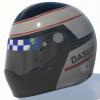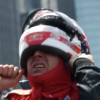

Allan Simonsen RIP
#201

Posted 27 June 2013 - 00:23

Advertisement
#202

Posted 27 June 2013 - 05:38
My heart goes out to the family and the Aston team.
As mentioned above, Rocky crashed on the exit of Tertre Rouge in a R10. 2007 LeMans.
Rockenfeller has crashed twice at Le Mans.
2007 at the exit of Tetre Rouge when he spun and hit the barriers backwards. Big enough accident to force the car to retire from the race but not a huge accident.
2011 at the kink on the Mulsanne straight at Indianapolis when a lapped Ferrari moved over on him, and Rockenfeller was forced into a huge accident sending him from side to side on the track and finally landing outside the track and barriers.
#203

Posted 27 June 2013 - 06:01
Quite rightly so. You can't possibly learn the lessons of an event like this in the space of a few minutes. Those barriers had been there, in that configuration, for a long time, so I don't think it's very helpful to lose perspective on the level of risk posed by them. The response to Allan Simonsen's accident was swift and professional, after Allan had been transported to the medical centre the track was cleared and the barriers repaired and the race, quite properly, went on, as it always has in the past when such things have happened.
The accident will be carefully and systematically investigated, and hopefully after that the right lessons will be learned, and serious thought will be given to how to organise things so that, in "normal" accidents where the car stays on or close to the ground and doesn't fly over the barriers, it will no longer be possible for racing cars to encounter resistance from trees or other such unyielding objects, not just at Tetre Rouge, but at every corner on every FIA homologated circuit, including street circuits. Not only might that form part of a fitting legacy to Allan Simonsen, but it's the sort of thing that should be looked into as a matter of course in circumstances such as these.
I have forced myself to watch Alan Simonson's crash again. He died when his car hit a guardrail on the outside of a corner, a prime target area for out-of-control race cars. Again – he hit a guardrail. Where was the tirewall? Where were the foam barriers? And don't give me cost as an excuse – what is the price of his life? How many old tires are there in France, that could have been used for tirewalls? LeMans needs to come into the 21st century.
RIP Alan.
Bruce, Big Sur, Ca
#204

Posted 27 June 2013 - 06:24
I have forced myself to watch Alan Simonson's crash again. He died when his car hit a guardrail on the outside of a corner, a prime target area for out-of-control race cars. Again – he hit a guardrail. Where was the tirewall? Where were the foam barriers? And don't give me cost as an excuse – what is the price of his life? How many old tires are there in France, that could have been used for tirewalls? LeMans needs to come into the 21st century.
RIP Alan.
Bruce, Big Sur, Ca
The same can be said for a lot of other races and race tracks including examples such as Spa, Nordschleife, Road America to name just a few. Not to mention the whole concept of Formula One.
There are a lot of accidents waiting to happen where we with the benefit of hindsight could say "Why didn't they?"
Motorsport is fundamentally dangerous and it's important that it is taken seriously and safety is at the forefront, and that all accidents is learnt from so it hopefully can't happen again. Especially the fatal ones but of course all of them.
But let's not be naive, cost will always be one of many factors behind what safety measures to be taken. Just as tradition, history and the feeling of the sport also will play a part. If it didn't Formula One and IndyCar for instance would look totally different today.
#205

Posted 27 June 2013 - 08:26
I have forced myself to watch Alan Simonson's crash again. He died when his car hit a guardrail on the outside of a corner, a prime target area for out-of-control race cars. Again – he hit a guardrail. Where was the tirewall? Where were the foam barriers? And don't give me cost as an excuse – what is the price of his life? How many old tires are there in France, that could have been used for tirewalls? LeMans needs to come into the 21st century.
RIP Alan.
Bruce, Big Sur, Ca
Unless you were calling for a tyre wall to be put in before the race, it isn‘t particularly helpful or fair to criticise the ACO now. Rest assured, there will be improvements for next year‘s race. The ACO doesn‘t need us to tell it there‘s a problem now.
If I understand the layout correctly, the tarmac of the public road goes more or less right up to the line of trees, so when the barriers were put in in the early 80s, rather than make holes in the public road to allow the barrier supports to be put in, they took the easy option of making the holes just beyond the edge of the tarmac, in line with the trees, so that the barrier itself would fit snugly in front of the trees. That‘s early 80s track safety for you. It was safer than what went before: unguarded trees. Perhaps the solution is to simply move the barrier forwards, which may mean making holes in the public road that would take the vertival supports for the armco, and which would have to be covered over when the public road is open. And get rid of some of that paint.
What I‘m hoping is that they will not merely fix Tetre Rouge, but that the relevant lessons will be applied to the inspection and certification of tracks worldwide, and modifications made where necessary.
#206

Posted 28 June 2013 - 01:30
Rockenfeller has crashed twice at Le Mans.
2007 at the exit of Tetre Rouge when he spun and hit the barriers backwards. Big enough accident to force the car to retire from the race but not a huge accident.
2011 at the kink on the Mulsanne straight at Indianapolis when a lapped Ferrari moved over on him, and Rockenfeller was forced into a huge accident sending him from side to side on the track and finally landing outside the track and barriers.
Right. I think we are all aware of his 2011 incident as well as McNish's. I was answering the question posed.The exit of Terte Rouge is quite fast; particularly after the most recent modification which incidently was in 2007. I'm not stating it was a "huge" accident but the link below can provide context to what we now know.
In any case, it is a rare place to have an accident in my opinion. However, now that a clear deficiency has been exposed consideration must be made to improve the situation.
#207

Posted 28 June 2013 - 05:26
Finally - as fantastic as something like an F1 car is in terms of safety, if a similar accident as this was to occur, I'm not so sure that the outcome would be hugely different.
I don't think that's a useful comparison. A GTE is over twice the weight of an F1 car thus carries alot more intertia even at lower speeds.
#208

Posted 28 June 2013 - 20:07
The problem at Tetre Rouge is that it is a main trunk road where there is a line of trees immediately beside the kerbing. ACO can't install a barrier in the middle of the road. THe road is only closed when needed for racing. It is re-opened ASAP after the race (or after practice or whatever). There isn't really much scope for lengthy work installing and removing a barrier. Installing tyrewalls or other measures on the surface of a public road that would take a long time to put in place and to remove afterwards probably simply isn't practical. After the race, we left by driving along that road, right past the accident site. It was touching that Danish fans had already set up a memorial with a flag, wreath and messages.Unless you were calling for a tyre wall to be put in before the race, it isn‘t particularly helpful or fair to criticise the ACO now. Rest assured, there will be improvements for next year‘s race. The ACO doesn‘t need us to tell it there‘s a problem now.
If I understand the layout correctly, the tarmac of the public road goes more or less right up to the line of trees, so when the barriers were put in in the early 80s, rather than make holes in the public road to allow the barrier supports to be put in, they took the easy option of making the holes just beyond the edge of the tarmac, in line with the trees, so that the barrier itself would fit snugly in front of the trees. That‘s early 80s track safety for you. It was safer than what went before: unguarded trees. Perhaps the solution is to simply move the barrier forwards, which may mean making holes in the public road that would take the vertival supports for the armco, and which would have to be covered over when the public road is open. And get rid of some of that paint.
What I‘m hoping is that they will not merely fix Tetre Rouge, but that the relevant lessons will be applied to the inspection and certification of tracks worldwide, and modifications made where necessary.
Personally, I saw this as a bit of a freak accident with a tragic outcome. There is a great deal of the fashionable tarmac runoff which should have slowed the car. And it was unusual that a car took the trajectory that this one took. The best option might be to build an angled wall on the other side of the public road where the grass area is.
#209

Posted 29 June 2013 - 10:16
The problem at Tetre Rouge is that it is a main trunk road where there is a line of trees immediately beside the kerbing. ACO can't install a barrier in the middle of the road. THe road is only closed when needed for racing. It is re-opened ASAP after the race (or after practice or whatever). There isn't really much scope for lengthy work installing and removing a barrier. Installing tyrewalls or other measures on the surface of a public road that would take a long time to put in place and to remove afterwards probably simply isn't practical. After the race, we left by driving along that road, right past the accident site. It was touching that Danish fans had already set up a memorial with a flag, wreath and messages.
Personally, I saw this as a bit of a freak accident with a tragic outcome. There is a great deal of the fashionable tarmac runoff which should have slowed the car. And it was unusual that a car took the trajectory that this one took. The best option might be to build an angled wall on the other side of the public road where the grass area is.
IMO its better to spend some time assembling/disassembling barriers rather to create risk to drivers.
#210

Posted 29 June 2013 - 11:13
I was answering to those that say this is a freak accident.
Edited by AlexS, 29 June 2013 - 11:14.
#211

Posted 29 June 2013 - 12:02
What I mean is that it may not be as easy as that. I don't know what the relationship is between the ACO and the authorities responsible for the public highway, but there may be problems if an extra hour or whatever is needed at both ends of a road closure period in order to construct and remove extra barrier material that is impinging onto the main road.IMO its better to spend some time assembling/disassembling barriers rather to create risk to drivers.
It is a big job to open and close this track. From Tetre Rouge to the start of the Porsche Curves is all public road, probably 6 or 7 miles, where all the junctions have to be closed off, barriers moved into place, white lines painted or scrubbed out and so on. Drive around that stretch slowly and look at all the work needed and then remember that it is closed off for each practice session, for qualifying, and for the race, and re-opened after each one. This isn't Monaco, it is the outskirts of a working city, and Mulsanne is a major road from Le Mans to Tours. From my experience of closing off roads for rally stages, I know the amount of work required, and Le Mans is many times more intensive than that.
I am sure ACO will be looking at this to see what can be done, but it has to be an exercise in what is practical.
Edited by BRG, 29 June 2013 - 12:02.
#212

Posted 29 June 2013 - 15:05
What I mean is that it may not be as easy as that. I don't know what the relationship is between the ACO and the authorities responsible for the public highway, but there may be problems if an extra hour or whatever is needed at both ends of a road closure period in order to construct and remove extra barrier material that is impinging onto the main road.
It is a big job to open and close this track. From Tetre Rouge to the start of the Porsche Curves is all public road, probably 6 or 7 miles, where all the junctions have to be closed off, barriers moved into place, white lines painted or scrubbed out and so on. Drive around that stretch slowly and look at all the work needed and then remember that it is closed off for each practice session, for qualifying, and for the race, and re-opened after each one. This isn't Monaco, it is the outskirts of a working city, and Mulsanne is a major road from Le Mans to Tours. From my experience of closing off roads for rally stages, I know the amount of work required, and Le Mans is many times more intensive than that.
I am sure ACO will be looking at this to see what can be done, but it has to be an exercise in what is practical.
Yes but what they have at the moment isn't good enough, and to be honest if you'd shown me that picture of the tree abutting against the barrier before the race, before the tragic accident, I'm sure I'd have been pretty strongly of the view that it wasn't good enough even then, as would most people. Fixing this problem is essential and while it has to be an exercise in what is practical and possible, it need not be constrained by what is easy or convenient. At the end of the day those trees can't be moved back, so either the trees will have to go or the barrier has to go and be replaced by a differently designed barrier that can be installed on top of the tarmac and removed again.
For example, one solution which may be neither convenient nor cheap but which is certainly possible is to design a barrier where the vertical supports screw into the ground. So you make the holes in he road, put hollow metal cylinders into the ground which are threaded on the inside, and then fit a small trapdoor above that so that when the barrier supports are taken out, the trapdoor closes and road traffic can drive over the place where the holes are safely. It would also make it a quicker job than it might otherwise be to assemble and disassemble the barrier during race week, since it could be designed in such a way that everything could be screwed or bolted together then unbolted and unscrewed again. Or maybe there's a more practical way of achieving the same result. We'll have to wait and see what they come up with. They've got, what, 10 or 11 months until practice week? Since it's a road section and they'll have to deal with local government if they want to do anything, I'd say they'd better get their thinking caps on and work out what needs to be done asap.
#213

Posted 29 June 2013 - 16:50
No the REAL issue is the trees!The problem at Tetre Rouge is that it is a main trunk road where there is a line of trees immediately beside the kerbing. ACO can't install a barrier in the middle of the road. THe road is only closed when needed for racing. It is re-opened ASAP after the race (or after practice or whatever). There isn't really much scope for lengthy work installing and removing a barrier. Installing tyrewalls or other measures on the surface of a public road that would take a long time to put in place and to remove afterwards probably simply isn't practical. After the race, we left by driving along that road, right past the accident site. It was touching that Danish fans had already set up a memorial with a flag, wreath and messages.
Personally, I saw this as a bit of a freak accident with a tragic outcome. There is a great deal of the fashionable tarmac runoff which should have slowed the car. And it was unusual that a car took the trajectory that this one took. The best option might be to build an angled wall on the other side of the public road where the grass area is.
Why on earth are they so close to an public road.
Normal motorists don't even have the ACO...
#214

Posted 29 June 2013 - 19:19
No the REAL issue is the trees!
Why on earth are they so close to an public road.
Normal motorists don't even have the ACO...
#215

Posted 30 June 2013 - 10:06
You totally missed the point.
You've never seen a tree lined road before? It is an iconic French thing. Anyway, on a dead-straight road, trees at the side are hardly much of an issue, that's why you will find similar tree lined roads in nearly every country of the world.
I know the situation in France, I have lived there, have you?
And if you do...you can see many memorial places also on the straights. Trees close to roads are stupid, regardless if they exist today on not.
#216

Posted 30 June 2013 - 11:09
Guess he's too crash-happy in Le mans. His crash in the R15 was at the Dunlop curve. Had it mixed up.Right. I think we are all aware of his 2011 incident as well as McNish's. I was answering the question posed.The exit of Terte Rouge is quite fast; particularly after the most recent modification which incidently was in 2007. I'm not stating it was a "huge" accident but the link below can provide context to what we now know.
In any case, it is a rare place to have an accident in my opinion. However, now that a clear deficiency has been exposed consideration must be made to improve the situation.
#217

Posted 30 June 2013 - 11:17
RIP Andrea Mame who died following injuries sustained during a multi car accident at the start of the Lamborghini Blancpain Super Trofeo at Circuit Paul Ricard this morning.
Link to Autosport news release
#218

Posted 30 June 2013 - 18:37
Yes, I have lived there (just over the border from Geneva in fact), not that makes any difference at all. Those memorials aren't for people who hit trees, they are mostly for nutters trying to overtake in the wrong place whilst driving a 2CV.You totally missed the point.
I know the situation in France, I have lived there, have you?
And if you do...you can see many memorial places also on the straights. Trees close to roads are stupid, regardless if they exist today on not.
#219

Posted 01 July 2013 - 12:07
Ok I'll take it you are perfectly fine with trees close to the roads - a very strange view I have to say. But ok you are entirely right to have that view. I hope you never have a puncture whatever in such an alley...Yes, I have lived there (just over the border from Geneva in fact), not that makes any difference at all. Those memorials aren't for people who hit trees, they are mostly for nutters trying to overtake in the wrong place whilst driving a 2CV.
Advertisement
#220

Posted 01 July 2013 - 15:34
You're just being ridiculous. What do you want? A 500 metre exclusion zone on each side of every road, with no trees, bushes, kerbs, buildings, lampposts, road signs, fences, walls, pedestrians or anythign solid at all to get in the way when you veer suddenly off the road? Perhaps you should stick to travelling by train.Ok I'll take it you are perfectly fine with trees close to the roads - a very strange view I have to say. But ok you are entirely right to have that view. I hope you never have a puncture whatever in such an alley...
#221

Posted 01 July 2013 - 16:10
I'm trying to be serious, are you?You're just being ridiculous. What do you want? A 500 metre exclusion zone on each side of every road, with no trees, bushes, kerbs, buildings, lampposts, road signs, fences, walls, pedestrians or anythign solid at all to get in the way when you veer suddenly off the road? Perhaps you should stick to travelling by train.
Safety is a serious matter.
Allan would be alive if it wasn't for that tree. It was a freak accident, these ALSO happen on public roads.
Removing hard objects close to roads are about to happen.
Please read about this non profit organisation - Global Road Safety Partnership
http://www.grsproads...-infrastructure
Download this document
http://www.grsproads...ent_English.pdf
Here are two parts from that dokument, enjoy.
For example, it is not feasible to lower speeds on rural roads to 50 km/h (the speed at which
a side-impact collision would be survivable) if there are trees or poles adjacent
to the roadway. The answer lies in removal of the hazards or installation of
protective barriers.
Rural Run-off-road crashes (often fatal because of higher travel speeds)
• Lower speed limits to reduce crash likelihood
• Some enforcement of limits
• Engineering treatments
––sealing of shoulders
––delineation of the through lanes (edge and centre-line marking)
––realignment of high-risk curves
––establishing clear zones free of trees, poles and other obstacles
(remove, relocate or shield vehicles from obstacles)
––hazard markers and advisory speed signs
#222

Posted 02 July 2013 - 12:27
Being serious has to include a large element of realism. Frankly, I was being a bit facetious, but the documents you now present would seem to show that my facetiousness doesn't in fact match the real daftness of those proposals which have not even got the slightest whiff of realism or common sense about them and were doubtless drafted by the usual bunch of car hating ecomentalists. Anyone who really proposes taking a chain saw and removing every tree adjacent to every road across the whole world is a candidate for sectioning. Far better, cheaper and safer to simply ban all wheeled traffic altogether, then there will never be another accident. Except for when we fall off our horses, of course.I'm trying to be serious, are you?
Safety is a serious matter.
Allan would be alive if it wasn't for that tree. It was a freak accident, these ALSO happen on public roads.
As for poor Mr Simonsen, well, perhaps he might have survived, or perhaps he might not. We simply don't know. If the tree hadn't been there, the barrier might have given way and the car plunged down the bank into the tram depot, with who knows what result? What I do know is that a knee jerk reaction of cutting that tree down isn't the answer.
#223

Posted 02 July 2013 - 13:17
What I do know is that a knee jerk reaction of cutting that tree down isn't the answer.
Australian Rally Driver Simon Evans will also tell you that tree stumps can hurt just as much. One year in Tasmania he struck a wide one side-on - it bent the rollcage and snapped his femur.
#224

Posted 22 March 2015 - 13:31
As the WEC season approaches I've been thinking about Allan Simonsen's death and how little was ultimately said about the circumstances and what happened next. The barrier at Tertre Rouge was moved towards the circuit to make it much safer. Although it's never been said by the authorities it's highly likely Allan Simonsen wouldn't have suffered the same level of force if the circuit had considered the consequences of a tree being directly behind a barrier. That's tragic and should have been publicized a lot more. The best way to raise standards across the world is to learn lessons and hopefully influence other circuit authorities to take action. It's not enough to shrug our shoulders and say 'that's racing'.
Edited by jr80, 22 March 2015 - 13:31.
#225

Posted 24 April 2016 - 15:20
Edit
http://www.fiainstit...s/#.VxzkdhnTXqA some information here although I find it slightly disengenous not to mention the avoidable issues with the barriers that magnified the impact Simonsen endured.
Edited by jr80, 24 April 2016 - 15:30.




















